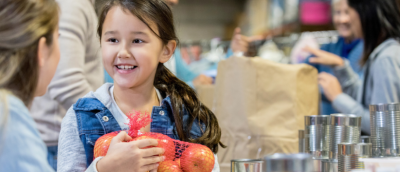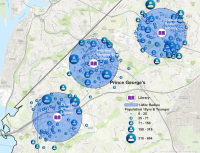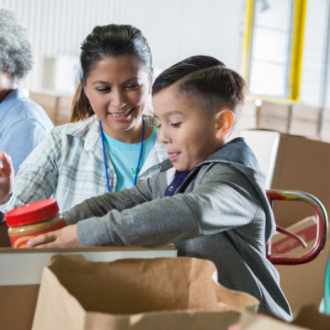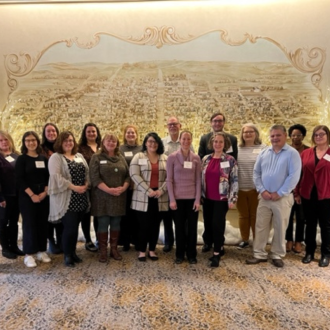Libraries: Nourishing Children's Minds and Bodies

Written by ULC's Director of Research and Data Femi Adelakun, ULC's Director of Democracy and Community Impact Shari Henry and ULC Program Manager Katie Sullivan
For a community to be food secure, food must be accessible (physically and economically), affordable and nutritious. As we have come to know, food access is tied closely to the population’s income and purchasing power, leaving low-income communities at a tremendous disadvantage. Food access is also affected by geographic barriers including transportation infrastructure, walkability, proximity to quality food options, and access to vehicles and public transportation.
The enduring racial wealth divide in the U.S. economy shaped by systemic racism has profoundly impacted the food security of communities of color. Black households experienced food insecurity at 22%, with Latinx families at 17%, in contrast to the 7% white families experienced. Black households consistently have the highest rate of food insecurity in the United States, with an estimated 24% of the Black population experiencing food insecurity in 2020. Research has shown the higher poverty rate for Black Americans, a result of discriminatory policies and practices, increases the likelihood of experiencing hunger.
Black households experienced food insecurity at 22%, with Latinx families at 17%, in contrast to the 7% white families experienced. Black households consistently have the highest rate of food insecurity in the United States, with an estimated 24% of the Black population experiencing food insecurity in 2020.
Libraries across North America have been embracing a role in food access and nutrition information for decades, and are increasing their role as they see needs arise. They are employing a range of programs and services to address barriers to food security in their communities. When ULC asked in a recent survey about the programs they provide to create and support greater food outcomes, the top common response by libraries was food distribution for youth; 49% of libraries reporting they provide such services.
Many public libraries serve as sites for the USDA afterschool and summer meal programs. Central Arkansas Library System’s Be Mighty program provides afterschool and summer meals in Little Rock, funded through federal dollars and the Walmart Foundation, and in partnership with the National League of Cities and the Food Research and Action Center, among others. St. Charles City-County Library (Mo.) has run summertime Lunch @ the Library programs, where youth 18 and under may pick up lunch to take with them.

Prince George’s County Memorial Library System (Md.) is one such system, finding a way that makes sense for the library to support food security within its jurisdiction. The library hosts an annual “Free Summer Meals at Libraries for Prince George’s County Youth'' in eight of their locations. ULC worked with PGMLS staff to review the program to demonstrate its reach and provide data as a model for other libraries to visualize the possibilities of data collection. A review of the program shows an estimated 40,000 youth 18 years and younger within one-mile of each participating library gain access to healthy food options and free summer meals via this library vital program.
The map below shows a section of the participating PGCMLS libraries and the youth population within a one-mile radius.

- Free Summer Meals program runs from June 27 to August 12 annually.
- Participating libraries include Beltsville, Hyattsville, New Carrollton , Spauldings, Glenarden, Fairmount Heights, Hillcrest Heights and Oxon Hill.
- Total number of youth within a one-mile radius of participating libraries is approximately 41,120.
Lauren Boeke, Assistant Youth Services Coordinator for Toledo-Lucas County Public Library, participated in the recent Food Justice convening hosted by ULC. Keenly aware of the needs of the children coming through the library’s doors, she says, “Kids are coming with MORE - more trauma, more hunger, more gaps to close. We’ve got to be there to work with our community.”
Libraries are in the barrier-breaking business in our communities. They do so by providing resources and information to the communities they serve. As people come in needing “more,” we respond by working with partners to close gaps where we see them. More food access and nutrition information are necessary, and libraries are responding, as we can see so clearly by the interactive map above.
To learn more about ULC’s Food Security Initiative, click here.
Food is a Right: Libraries and Food Justice
White Paper, Libraries and Food Security Initiative
© Urban Libraries Council 2023
ULC’s newest White Paper, Food is a Right: Libraries and Food Justice, offers library leaders meaningful steps forward in their work on addressing this vital issue, including providing effective and replicable practices to guide the field in co-creating solutions with local communities.
Related Articles

Fighting for Food Justice: The Words We Use Matter
In the work of food security, it is important to understand that the words we use can directly impact the success of our work. Read about the language that stood out and evolved at a recent ULC convening of food justice.
Learn More

Libraries and Food Security: Bringing Together Grassroots Efforts, Cultural Relevance and Innovation
On December 7-9, 2022, library leaders and partners from 20 organizations gathered for a convening on the role of libraries in food justice. The convening emphasized how libraries of all sizes can support residents who lack access to nourishing food and nutrition information.
